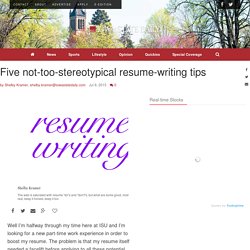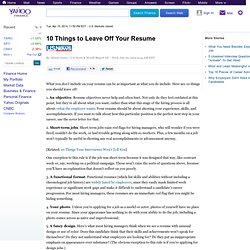

Five not-too-stereotypical resume-writing tips. Well I’m halfway through my time here at ISU and I’m looking for a new part-time work experience in order to boost my resume.

The problem is that my resume itself needed a facelift before applying to all these potential employers. While trolling the Intranet for helpful hints when writing my new resume, I came across a Forbes article and an article from Monster. This information, paired with my own experiences, I’ve come up with some hints on how you can write your better resume. 1. Get rid of the white lies. Redirecting... Best 50 Niche Job Boards. Your resume will get more calls if you do this. Tips For Writing The Perfect Resume.
If you’re currently seeking paid employment, a little bit of empathy can go a long way.

Imagine being the one tasked with assessing hundreds and hundreds of resumes per week, if not per day. How To Explain A Gap On Your CV. Common Resume Mistakes. Should you post your resume on a job board? The 3 Biggest Resume Mistakes. Re. 6 Resume Red Flags for the Modern Age. As we all know times are changing and the recruitment and candidate market place is changing with it.

Candidates no longer submit hand-written, hard copy resumes; they don’t always interview face-to-face. No-one expects a job for life these days; candidates have a wealth of job search information resources available to them on the Internet and they can apply for jobs at the click of a button. These changes to the recruiting and job seeking landscape are beginning to filter through to the resume short-listing process, which must adapt to suit the modern marketplace. For example, where once a candidate who changed jobs twice in a decade might have seemed unstable, in the modern age this might be the norm and could even constitute a long tenure. So, I thought it would be a good time to take stock five of the key resume red flags and update them to ensure they are in line with the modern age. 1. 2. 3. 4. 5. 6. 10 Things to Leave Off Your Resume. What you don't include on your resume can be as important as what you do include.

Here are 10 things you should leave off: 1. An objective. Resume objectives never help and often hurt. Not only do they feel outdated at this point, but they're all about what you want, rather than what this stage of the hiring process is all about--what the employer wants. How to Write a Résumé That Doesn't Annoy People - David Silverman. How to Write a Résumé: Advice for Older Job Seekers. Why Companies Can't Find the Employees They Need. 12 Eye-Catching Resume Tips. InShare761 Gone are the days of simply mailing your resume, receiving a call, shaking hands at the interview and agreeing on a start date for that new job.

The Internet has taken over the recruiting landscape and everyone is required to submit a resume online. While that brings greater efficiency to the process for employers, it can be awfully maddening for job seekers. But it doesn’t have to be that way if you know how to navigate the system. Consider these 12 tips before pressing “submit:” 1) Search job boards and the websites of employers that appeal to you. 2) Use a highlighter to mark the keywords and industry language used to describe the requirements and responsibilities of each position. 3) Compare those words and phrases to the language that appears in your current resume. 4) Figure out how and where to add the most relevant keywords to your resume, assuming you have the specific knowledge, skills and experience.
How Recruiters See Your Resume. A List of Google Custom Search Engines - Boolean Strings Network.
College Recruiting. A Recruiter Competency Model for Passive Candidates. You can’t recruit and hire passive candidates using the same workflow nor the same recruiters used for active candidates.

We conducted an in-depth survey with LinkedIn last year that indicated that 82% of their fully-employed members were unlikely to even consider switching jobs unless directly contacted by a recruiter or through an employee they’ve worked with closely in the past. This increased slightly to 83% in this year’s survey. This is shown on the graph, with the dark blue line representing the satisfaction level of those surveyed (4,550 fully-employed LinkedIn members) comparing their job seeking status and job requirements over time. From a strategy standpoint, the idea is to find candidates either the moment they actively enter the job market, or before. But to do this, you need a different process for sourcing and recruiting the 83% who are not actively looking than used for those who are. Here a just a few of the big ones:
Where to Recruit Great Employees: 5 Ideas. "To succeed, surround yourself with great talent. " Sounds great. Also sounds expensive. Hiring the best is really hard to pull off in practice, especially if your goal is to hire Lamborghinis and all you have is a Kia budget. So what can you do? Art Profiles.